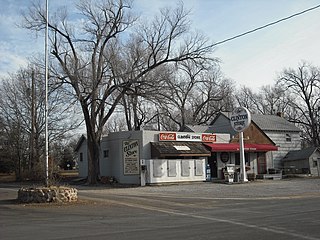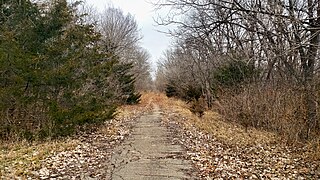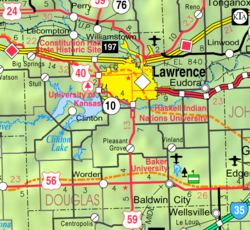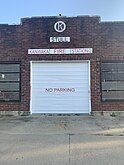
Halloween or Hallowe'en is a celebration observed in many countries on 31 October, the eve of the Western Christian feast of All Hallows' Day. It is at the beginning of the observance of Allhallowtide, the time in the liturgical year dedicated to remembering the dead, including saints (hallows), martyrs, and all the faithful departed. In popular culture, the day has become a celebration of horror, being associated with the macabre and supernatural.

Kansas is a landlocked state in the Midwestern region of the United States. It borders Nebraska to the north; Missouri to the east; Oklahoma to the south; and Colorado to the west. Kansas is named after the Kansas River, in turn named after the Kansa people. Its capital is Topeka, and its most populous city is Wichita, however the largest urban area is the bi-state Kansas City, MO–KS metropolitan area.

Douglas County is located in the U.S. state of Kansas. Its county seat and most populous city is Lawrence. As of the 2020 census, the county population was 118,785, making it the fifth-most populous county in Kansas. The county was named after Stephen Douglas, a U.S. Senator from Illinois and advocate for the popular sovereignty choice in the Kansas slavery debate.

Lawrence is a city in and the county seat of Douglas County, Kansas, United States, and the sixth-largest city in the state. It is in the northeastern sector of the state, astride Interstate 70, between the Kansas and Wakarusa Rivers. As of the 2020 census, the population of the city was 94,934. Lawrence is a college town and the home to both the University of Kansas and Haskell Indian Nations University.

Lecompton is a city in Douglas County, Kansas, United States. As of the 2020 census, the population of the city was 588. Lecompton was the de jure territorial capital of Kansas from 1855 to 1861, and the Douglas County seat from 1855 to 1858. Anti-slavery Lawrence became the de facto capital during the latter part of this period, when the county seat was moved there. This time period was known as Bleeding Kansas, due to the violence perpetrated by the pro-slavery, and to a lesser extent the anti-slavery, factions in the eastern part of the state. Lecompton was a hotbed of pro-slavery sentiment during the mid-1800s.
For many decades, Kansas has had a vibrant country and bluegrass scene. The Country Stampede Music Festival – one of the largest music festivals in the country – and the bluegrass/acoustic Walnut Valley Festival are testament to the continued popularity of these music genres in the state. Among current leading country artists, Martina McBride and Chely Wright are natives of Kansas.

Legend tripping is a name bestowed by folklorists and anthropologists on an adolescent practice in which a usually furtive nocturnal pilgrimage is made to a site which is alleged to have been the scene of some tragic, horrific, and possibly supernatural event or haunting. The practice mostly involves the visiting of sites endemic to locations identified in local urban legends. Legend tripping has been documented most thoroughly to date in the United States.

Bleeding Kansas, Bloody Kansas, or the Border War was a series of violent civil confrontations in Kansas Territory, and to a lesser extent in western Missouri, between 1854 and 1859. It emerged from a political and ideological debate over the legality of slavery in the proposed state of Kansas.

Wilson Shannon was a Democratic politician from Ohio and Kansas. He served as the 14th and 16th governor of Ohio, and was the first Ohio governor born in the state. He was the second governor of the Kansas Territory.
The Wyandotte Constitution is the constitution of the U.S. state of Kansas.

The following is an alphabetical list of articles related to the U.S. state of Kansas.

Clinton is an unincorporated community on a peninsula next to Clinton Lake in Douglas County, Kansas, United States.

Richland is currently a ghost town in southeastern Shawnee County, Kansas, United States.

Big Springs is an unincorporated community in northwest Douglas County, Kansas, United States.

Kanwaka Township is a township in Douglas County, Kansas, USA. As of the 2000 census, its population was 1,317. The name is a portmanteau of the Kansas River and Wakarusa River.
James Paramore is a former American football player, coach, and official. He served as the head football coach at Southwestern College in Winfield, Kansas from 1973 to 1976 and Bethel College in Newton, Kansas from 1977 to 1978, compiling a career college football coaching record of 27–36.

Samuel Dexter Lecompte was an American jurist best known for his extreme pro-slavery views, his involvement in the events of Bleeding Kansas, and for being the founder and namesake of Lecompton, the erstwhile capital of the Kansas Territory.
Fort Saunders, 4 miles (6.4 km) southeast of Clinton, Kansas, and 12 miles (19 km) southwest of Lawrence, Kansas, was owned by James D. Saunders, a militia captain. What little was left of Clinton disappeared during construction of the Clinton Lake in the 1960s; only an outbuilding that was converted into a museum remains.

Stull is the second extended play by the alternative rock band Urge Overkill. It was released in 1992 and would be the band's final major release on independent label Touch and Go Records. The EP's title and cover are direct references to Stull Cemetery, located just west of Lawrence, Kansas. Since the 1970s, urban legends have been spread that the cemetery is one of the seven portals to Hell. Stull also includes a cover of Neil Diamond's song "Girl, You'll Be a Woman Soon", which would later be re-released on the soundtrack to Quentin Tarantino's 1994 film Pulp Fiction. Upon re-issue, Urge Overkill's version of "Girl, You'll Be a Woman Soon" charted at number 59 on the Billboard Hot 100. The Stull EP received largely positive reviews from critics, with Stephen Thomas Erlewine of AllMusic and Johan Kugelberg of Spin both complimenting the record.



























